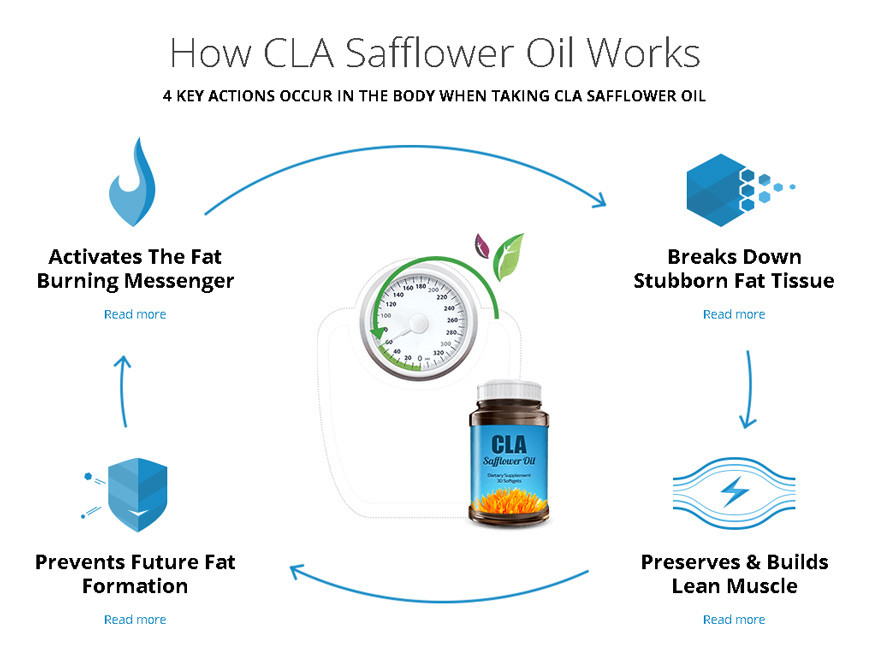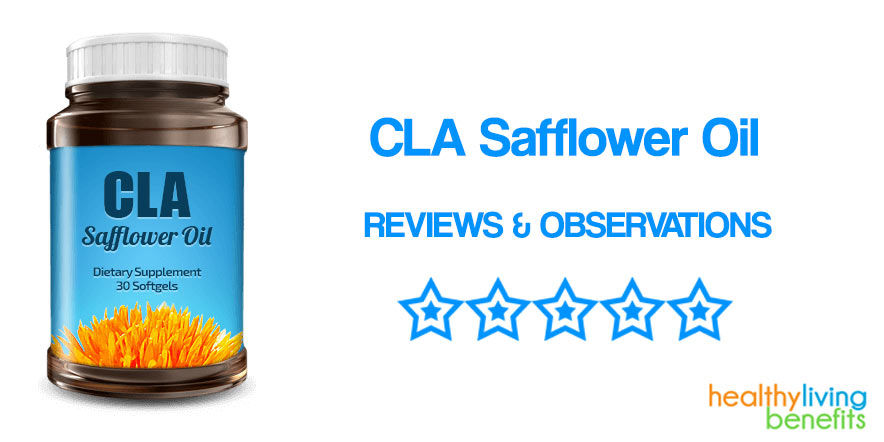There has been a hype for quite some time now about dietary supplements featuring CLA Safflower oil. Promising revolutionary changes for those with excess weight, one particular producer of such supplements have been marred by a rather crass scandal involving dubious marketing practices.
Even if we could put it out of our minds, the fact that CLA Safflower oil supplements are still being manufactured and commercialized warrants an in-depth analysis. Besides the obvious question that arises in the case of every supplement – does it really work? – there are some peculiarities in this case.
First of all, the designation can be slightly misleading. CLA and safflower oil are related yet different substances and, although they are presented as being a unitary extract, further inquiry and analysis of the compounds are needed.
Secondly, we should delve a bit deeper into the effects of the ingredients that make up these supplements in order to find out if they work towards achieving the goal of weight loss. Then there are technicalities – dosage, side effects and the like. We will provide you with the necessary information, starting with a separate discussion of CLA and then safflower oil (with arguments for and against the consumption of each), followed by an assessment of the existing body of reviews and rounding the article up with our verdict on the probability that CLA Safflower oil supplements could help anyone in their quest for a healthier and more appealing silhouette.
The CLA – Safflower Oil Connection
Some time ago, The American Heart Association released a suggestion concerning the benefits that Omega-6 fatty acids have on the overall heart health, urging their steady but moderate consumption. In the wake of this announcement, the number of studies undertaken on omega-6 acids, and polyunsaturated fats in general, have increased markedly. One such study, conducted at Ohio State University, was concerned with the effects of supplementation with safflower oil and conjugated linoleic acid (CLA) in menopausal, obese, diabetic women who did not require daily insulin injections. It was long speculated that this kind of supplementation would have a positive effect on weight loss efforts. Safflower oil (or rather a linoleic acid it contains) and conjugated linoleic acid share a chemical formula. However, their chemical structure differs slightly. They are related, but not quite the same.
The 35 women in the study were divided into two groups, individuals in each grouping being administered 6.4 grams of fatty acid daily, for 16 weeks, without any other tampering with medication, or with their routine in general.
The results were encouraging, to say the least. Subjects in the CLA supplementation group exhibited a significant decrease in the Body Mass Index indicator, half a point on average, a figure that translated into a drop of 3.2 percent from the total body fat. Subjects experiencing safflower oil supplementation, on the other hand, had a considerable reduction in their trunk fat, however with no significant consequences on their overall fat, and a remarkable increase in muscle tissue. Furthermore, the safflower oil supplemented group also exhibited a decrease in their blood sugar levels with an average of 15 points.
In the case of both parties, no other alterations in their health were observed, with the notable exception of the increase in the production of the hormone adiponectin, noticed in the group supplemented with safflower oil. This hormone is responsible for the pace at which fat is burned in the metabolism.
While these results were promising and certainly paved the way for a quick introduction on the market of CLA and safflower oil extract supplements, there are a few caveats to them. The big question sign the results of this study raised concerns about the excess fat. Where had it gone? After all, the exercise routine was not changed.
The noticeable increase in the adiponectin production raised parallels the dramatic side effects drugs that tamper with hormone levels have. The excess fat may be deposited in the liver and/or muscle tissue, therefore increasing the severity of diabetes (or causing it to individuals who do not suffer from the condition) or inducing a whole range of liver disorders.
This study indeed unearthed exciting benefits that both CLA and safflower oil may bring about, yet the possible side effects could not have been fathomed during the limited period (16 weeks) the scientists had at their disposal.
Now that we have seen how the underlying principle in the dietary supplements we are discussing came about let us get further acquainted with both CLA and safflower oil.
CLA (Conjugated Linoleic Acids)
The problem with CLA is not limited to grammar (i.e., should one use “CLA is” or “CLA are”, as some reviewers use them interchangeably), rather CLA are compounds that have not been sufficiently researched. Nevertheless, there is sufficient data relevant to their use in dietary supplements, and we should proceed with the analysis.
Conjugated linoleic acids are one of 28 isomers of linoleic acids that are produced naturally when certain dairy products or meats are broken down by bacteria in the stomach or intestines. The isomers of a certain substance have the same chemical formula (a single molecule contains the same elements in exactly the same number), yet they differ in their chemical structure. CLA is classified as trans- fatty acid and also cis- fatty acid, making them something of an oddity, at least in the biochemical realm.
This is where we can confront the “CLA – safflower oil” confusion and convolution of terms. Safflower oil contains traces of linoleic acid (however, more than 75 percent of it is oleic acid, a monosaturated acid) – approximately 0.7 mg/gram. Therefore, CLA and safflower oil are indeed substances that can be placed in the same category, yet they are by no means as alike as to have the same effect on the human body or to be used interchangeably. From a logical standpoint, that is why the study cited in the previous section used both substances, to find out the outcomes and, as we have seen, the outcomes, though both regard the reduction of body fat, proved indeed to be quite different.
CLA sprang into the spotlight as early as 1979, when a study performed on mice showed that the fatty acids had properties of visibly shrinking chemically induced tumors in mice. The studies have not slowed their pace since then. However, it was not until 2008 that the Food and Drug Administration (FDA) recognized CLA as being generally safe. Nevertheless, supplements containing CLA had been manufactured and marketed before, although the hype around CLA has magnified since that moment.
The human body naturally synthesizes CLA from linoleic acid through the aid of the bacteria from the Bifidus strain that reside in the intestine. A host of conditions and dysfunctions – ranging from high acidic levels to most digestive diseases and even gluten intolerance – make the synthesis impossible. Therefore, one can conclude that a supplementation of CLA is truly needed, especially from a certain age onwards, yet questions of dosage or method of administration remain.
At first, CLA supplements were mainly marketed as natural anti-cancer solutions, with their scientific basis being the rodent study cited above (although extrapolating from artificially induced cancer in mice to tumors on humans is a rather dubious practice). In recent years, and in the light of the study performed at Ohio State University, CLA supplements are part of the supplements that advertise weight loss.
According to the WebMD website, CLA is used in dietary supplementation, with doses between 15 to 175 mg for daily use. The purposes are diverse – cancer, combating mild food allergies, reducing the effects of chronic disease on weight or atherosclerosis. CLA is possibly effective in fighting obesity and high blood pressure, however, more research on the subject is required. On the subject of all other claims made by manufacturers, speculation can best characterize them. It is safe for the average healthy adult in the doses found in food and in most supplements, though in cases where surgery, bleeding disorders, and diabetes are present, one is advised to avoid CLA. Arriving at the subject of dosage, the results of the Ohio State study are quoted – no more than 7 grams per day, though there are no significant benefits for doses larger than 3.4 grams per day.
What is CLA’s Mechanism of Action?
CLA’S biochemical mechanism of action is related to its interaction with the PPAR receptors. Clinical studies investigating the acid’s effect showed lipogenesis reduction via molecule modulation on in vivo models. The findings also suggested that the isomers in conjugated linoleic acid might reduce adiposity by influencing energy metabolism.
The PPARs are a family of nuclear receptor proteins spread throughout the entire human body, but with a higher incidence rate in the adipose tissue. Three types of PPARs[1] have been identified and studied:
- PPAR-alpha, mainly found in the heart, liver and adipose tissue, responsible for triglyceride reduction and homeostasis
- PPAR-beta, expressed in brain and adipose tissue, involved in the fatty acid metabolism process
- PPAR-gamma, in the white adipose tissue and intestines, with role in glucose metabolism and insulin sensitization
The receptors are transcription factors, similar relations a ip to the thyroid hormones. They are stimulated by small ligands (functional groups of molecules with biological purpose) derived from the body’s lipid substrates. Evidence shows of roles in a series of processes ranging from lipid metabolism in obese models to pro-inflammatory enzyme inhibition. PPARs might have an antitumorigenic effect in patients who have colon cancer. In vivo studies indicate a decrease in plaque accumulation in the hippocampus and cortex of people with neurodegenerative diseases. Normal activity of all three receptors maintains homeostasis, which means the body has a good immune system and lower chances to develop severe medical conditions.
By activating the PPAR receptors, CLA is actively involved in numerous processes taking place inside the body. Various studies indicate that supplementation with CLA has anti-obesity effects in both animal and human models. A clinical trial conducted on rodents showed adipogenic process regression following the acid’s action on the PPAR-gamma receptor (a regulator of adipocyte differentiation).
Safflower Oil – Benefits and Risks
 Safflower oil has been used as cooking oil for a long time, though its benefits have begun to be touted only in recent years. Oleic acid (a monounsaturated fatty acid) is the main component of safflower oil, accounting for about 75 percent of it. Some polyunsaturated fatty acids account for 13 percent and saturated fatty acids make up approximately 8 percent. Per 100 ml of safflower oil, there is an intake of 34.1 mg of vitamin E and 7.1 mcg of vitamin K. An interesting side note about this type of oil is that it contains serotonin derivates, which have a proficient antioxidative effect.
Safflower oil has been used as cooking oil for a long time, though its benefits have begun to be touted only in recent years. Oleic acid (a monounsaturated fatty acid) is the main component of safflower oil, accounting for about 75 percent of it. Some polyunsaturated fatty acids account for 13 percent and saturated fatty acids make up approximately 8 percent. Per 100 ml of safflower oil, there is an intake of 34.1 mg of vitamin E and 7.1 mcg of vitamin K. An interesting side note about this type of oil is that it contains serotonin derivates, which have a proficient antioxidative effect.
Research on the effects of safflower oil consumption is in its infancy. However, there are some facts to be shared:
- A study has demonstrated it has some impact on the decrease of C-Reactive Protein, thus contributing to lowering the risk of cardiovascular disease.
- Safflower oil slightly increases the levels of the HDL-C lipoprotein, known as “good cholesterol”.
- Safflower oil negatively influences the metabolism of glucose through a slight elevation in the levels of glycated hemoglobin.
On the subject of the relationship between safflower oil and CLA supplementation, there seems to be sufficient evidence that the protective effect the oil has cannot be provided through the supplementation of isolated CLA. The possible cause for this is the significant input of vitamin E from safflower oil. However, when analyzing the potential action of safflower oil as a fat burner, there is insufficient evidence for it to be considered as such.
Safflower oil, however, may pose significant health threats on the other hand. This is mainly because there are two variants of safflower oil, one manufactured from the seeds of the plant, and the other resulting from the pressing of the flower. The latter option, in particular, may have pernicious effects such as:
- Worsening hypertension through the elevation of cholesterol levels, which are also a significant factor in the onset of diabetes.
- There have been some cases of diarrhea and other gastrointestinal problems.
- Polyunsaturated fatty acids in the variant extracted from the flower reduce the levels of HDL-C, in stark contrast to the variant extracted from the seeds of the plant.
- A recent study performed in Japan on rodents showed that safflower oil dramatically increases existing renal damage.
- Individuals with known allergic reactions from pollen, mugwort or ragweed, may want to steer clear of safflower oil.
According to the WebMD page dedicated to safflower, oil from the seeds of the plant is acknowledged as having several benefits for those seeking protection from cardiovascular disease. In fact, there is no mention to the flower, except that its consumption may induce spontaneous abortions, and that it has been used to this end in the past, and in some parts of the world it is still being used today. Because of the hype surrounding it, there are clear warnings that there is insufficient evidence that safflower oil is beneficial in scores of conditions, ranging from cystic fibrosis to hepatitis C. Yet more proof that you need to put a lot more effort into debunking myths than starting and spreading them.
CLA Safflower Oil Supplements – Claims, Marketing, and Reviews
Right from the start, we will state that there are precious few trustworthy reviews on the web concerning these kinds of supplements. Most of them are blatant boasts from the manufacturers themselves, either direct or disguised in third-party “independent” websites. Then there are others that offer little actual information and by no means do they separate the notions of CLA and safflower oil, or analyze the implications of multiple isomers and “naturally occurring” vs. “synthesized substances”.
Naturally, these supplements have been somewhat tainted by the aforementioned scandal regarding CLA Saffron Oil manufactured by Purists Elite and fake advertising. In fact, some well-known supplement review websites do not even take these types of supplements into account, not to mention the sudden disappearance of the manufacturer mentioned above.

The main selling point is, without a doubt, the weight loss properties. Some claims consider safflower as a miraculous plant that magically reduces levels of body fat without any exercise whatsoever. These types of claims are only backed by the already (in)famous Ohio State study. Let us remind you how the conduct and results of the study refute these statements: CLA supplementation and safflower oil was administered separately to two different groups; nowhere in the description was there ever specified that the women involved performed no physical exercises; those women had very specific characteristics, and the positive results achieved in their case definitely should not be extrapolated to other populations; the doses administered were quite high, certainly far more than those present in any dietary supplement; the limited duration of the study, which did not state if the changes had become permanent. All these, coupled with the fact that the study itself raised some safety issues which we have covered in one of the previous sections, confirm that there is no magical weight loss pill as if that was not already known.
The supplements’ manufacturers claim to deliver weight loss because they act as suppressors of appetite through an increase in the overall levels of serotonin and as blockers of fat. They provide no actual evidence. In fact, we have already stated that safflower oil does have abilities in elevating serotonin levels which may lead to a decrease in the need one feels, however, that cannot be construed as appetite suppressing.
A 2009 nutritional study published in the American Journal of Clinical Nutrition makes a serious claim to demonstrating links between the consumption of safflower oil and weight loss through the reduction of appetite, yet the dosage used in the test is far bigger than any supplement could provide.

Where to Buy Safflower Oil?
Cla Safflower Oil can be safely used by any individual over the age of eighteen with a good clinical health. Doctors advise people not to give safflower oil to their children unless a specialist recommends it. Such is the case with every person that takes CLA.
Thanks to its status as a weight loss aid, CLA safflower oil does not need medical approval upon purchase. Currently, the oil is an over-the-counter product one can either buy from a drug store or online.
People from all over the world can buy it at affordable prices from various websites. Specialists advise us to pay close attention to the CL safflower brand we want to purchase. It is advisable that interested customers should research pieces of information regarding the product, and see the entire list of ingredients (certain aids contain other substances in addition to conjugated linoleic acid). Also, one should make sure the website is safe, and the product it’s following the CLA’s benefits.
Thanks to its multiple benefits, CLA safflower oil is integrated with a variety of products. Its application is diverse. People use it as a cooking oil, margarine, dietary add or facial cream. Regarding supplementation, we cannot assert which product is the best on the market. There are some with a higher CLA dosage, while others have smaller concentrations, depending on the medical condition they are used for. Additionally, the efficacy of each product might be given by the nutrients CLA is mixed with as well.
Bottom Line
In the case of certain serious diseases, usually the serious ones, a doctor’s chief role is to make sure that the patient or his/her family reach an informed decision. Where the physician’s abilities to cure fail for whatever reason, this is all that can be done.

In the case of dietary supplements, the same could be said about those who review them. We cannot say with any degree of certainty if the public should or should not try one supplement or another. All we can do is present the facts as they are at a certain moment in time.
In this particular case, we are presented with a peculiar conundrum. From the facts that we have presented, the research regarding CLA and safflower oil, though in its infancy, has garnered mainly positive results – the two substances do seem to help with weight loss, although the risks posed by a long-term consumption are not quite clear. Nevertheless, the dubious marketing practices that have already shut down the activity of a manufacturer place raise warning signs about the probity of these companies.
The bottom line is that if you encounter a supplement that places all the information about the ingredients that make up the specific supplement and your doctor gives his/her consent, then there are no arguments against. One needs, however, to be very careful in the selection process.
Don't Miss the CLA Safflower Oil Special Offer
References


